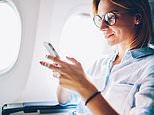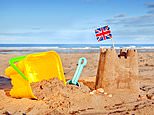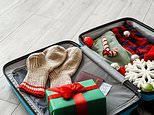
A retired pilot has shared what actually happens when passengers ignore the request to switch their devices to airplane mode during a flight.
Martin Drake, a former Boeing 747 captain and representative of the British Airline Pilots’ Association, recently shared some of the lesser-known realities of flying, from both a pilot and passenger’s perspective.
After take-off, if mobile phones and smart devices continue to be used as normal without activating flight mode, Drake revealed it’s not inherently dangerous – but it can be more of a headache for the crew than passengers realise.
The pilot explained that when people leave their phones or other electronic devices switched on during take-off or landing, it can cause interference with the aircraft’s audio systems.
He further shared that pilots can sometimes hear a ‘repetitive dinging sound’ while they’re trying to communicate with air traffic control.
Drake added to Sky News: ‘This is mainly a nuisance rather than anything more serious, though it’s something that pilots would rather not have bothering them while flying a plane.’
The retired pilot also shared some practical tips and safety advice for air travellers, starting with something as simple as the seatbelt sign.
He explained that when the sign is on, it means there’s a higher chance the aircraft might move suddenly – such as during take-off, landing, or turbulence.
Martin Drake , a former Boeing 747 captain and representative of the British Airline Pilots’ Association, recently shared with Sky News some of the lesser-known realities of flying (stock image)
Drake said: ‘If you leave your seat while the seatbelt sign is on, you risk injuring yourself or another person, possibly quite seriously.’
The pilot also revealed the best time to fly is usually mid-morning, as most people tend to be ‘be better rested and more relaxed’.
Drake also revealed his must-have travel accessory – a large, square feather pillow in a cotton pillowcase.
He said they squash down small in your luggage but make a big difference to comfort on a long flight – and can double up as an extra pillow at your hotel or accommodation.
Touching on flight safety once more, he revealed how cabin crews are trained to deal with unruly passengers on board, such as using de-escalation techniques.
But in more serious situations, the captain can authorise the use of restraint kits – which are carried on board just in case.
However, he emphasised that needing to physically restrain someone is very uncommon and is treated as a ‘last resort.’
Meanwhile, a seasoned pilot has shared practical advice for passengers tackling flying anxiety this summer – including the best time to travel and which seat to select.
The pilot explained that when people leave their phones or other electronic devices switched on during take-off or landing, it can cause interference with the aircraft’s audio systems
Captain Chris and his wife, Laurie, run their YouTube channel, Travel Tips by Laurie, where they regularly share luggage hacks, airport security advice, holiday outfit ideas, aviation secrets, and more.
In a recent video, part of their ‘Ask a Pilot’ series, Captain Chris, from the US, answered a range of questions sent in from their followers about flying – including how someone can combat nerves whilst taking to the skies.
According to the airline captain, early mornings are the best time to fly as the air is generally cooler and less turbulent before the day heats up, especially in summer.
This likely reduces the chances of bumps during takeoff and throughout the flight.
Share or comment on this article:
Pilot reveals what really happens when you don’t put your phone on airplane mode
Source link
CHECK OUT: Top Travel Destinations
READ MORE: Travel News



